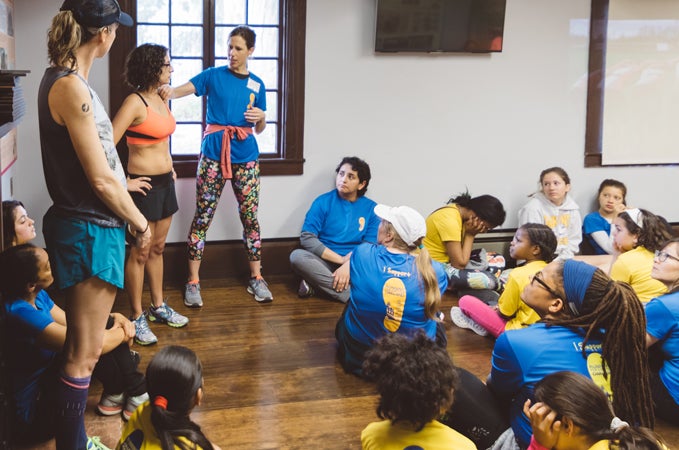New perk! Get after it with local recommendations just for you. Discover nearby events, routes out your door, and hidden gems when you sign up for the Local Running Drop.
Despite the well-known benefits of physical activity, four out of five children and adolescents in the United States fail to meet current physical activity guidelines. Underlying this statistic is an even more worrying one: girls are less physically active and report lower levels of participation in both sport and physical activity than boys.
This gender gap is well documented in running and triathlon. According to USA Triathlon data, multisport participation is equal for boys and girls until age 10, when female participation begins to decline. In running, 14-year-old girls drop out at two times the rate of boys. Though plenty of initiatives try to close this gender gap by making sport more appealing—girls-only sport programs, access to role models and mentors, and rewards for participation—the most effective solution could be as simple as outfitting tween girls with sports bras.
In a study conducted by the University of Portsmouth, nearly three-quarters of girls aged 11 to 18 said their breasts were the reason they pull out of sports. Discomfort from bouncing breasts is painful and embarrassing, and many girls are uncomfortable with the way their bodies change during puberty.
“Girls are less active because it may physically hurt to be active or they just feel embarrassed because their breasts are flopping around,” said Carrie Wagner of the Girls Athletic Leadership School (GALS), an all-girls public charter middle school in Los Angeles. “It is really hard to adapt to all the changes that are going on in the body for these girls.”
Despite an overwhelming need for a sports bra to accommodate their growing breasts, only 10 percent of girls in the University of Portsmouth study had ever worn one. Parents are often uncomfortable with the idea of buying a bra for their little girl, and daughters, who are already self-conscious about their changing bodies, can be reluctant to bring it up. In many cases, it’s simply easier to replace physical activity with pursuits that don’t require as much movement.
Oiselle is on a mission to change that. The Seattle-based running apparel brand aims to make sports bras a part of the cultural conversation through its Bras For Girls program, which equips tween girls with the knowledge and gear they need to keep running through puberty and beyond.

“We were seeing research that highlighted the prevalence of breast-related concerns among girls, and the influence of breast development on participation in sport,” said Sarah Lesko, who oversees philanthropy initiatives at Oiselle. “We happened to have some extra bra inventory at that time, so we put two and two together and realized we were in a great position to really make a positive impact.”
In the program, educators and elite runners visit schools, athletics programs, and community organizations like GALS to provide straightforward, usable information on breast development, bra selection, and fit. They conduct these workshops wearing their own sports bras, taking care to repeat “all breasts are normal” and “you are an athlete in your own body.” By demystifying breast development and bra shopping, girls become less likely to see their bodies as a barrier to physical activity. This notion is confirmed with the distribution of a free, well-fitting sports bra to every girl in the program, so girls can immediately get firsthand experience with the benefits of proper support.
“It’s a fairly simple intervention to give a girl a sports bra, but it’s powerful as well,” said Lesko. It lets her know her comfort is important, her changing body is normal, and moving her body should be fun.”
By removing this major barrier to sport at such a formative moment, Bras For Girls is giving participants easier access to the many documented benefits of sport in their adolescent and adult years, including better physical health, higher educational achievement, increased self-confidence and emotional well-being, and reduced rates of teen pregnancy, cigarette use, and drug use. The positive impact of a sports bra is often evident from the first day.
“The girls were so appreciative of the bras they received,” said Wagner. “We saw an immediate impact the next day during our morning movement program. We found that girls were more enthusiastic about participation and that they felt more comfortable in their bodies. Providing a sports bra that fits is one less thing for them to worry about. It gives them more confidence.”
Since launching Bras For Girls in 2017, Oiselle has donated more than 8,500 bras to middle-school girls in need, and is on track to hit 10,000 donated bras by the end of 2020.
“We’re dreaming big: a bra for every girl in the world!” Lesko declared. “Honestly, why should lack of a sports bra be a limiting factor for any girl? There is a huge need. The first year of Bras for Girls, we received donation requests for more than 68,000 bras. We are building more bra inventory each year for this program, as many bras as our budget allows, and we’d love to see all sporting goods companies in the world join us in donating bras.”
